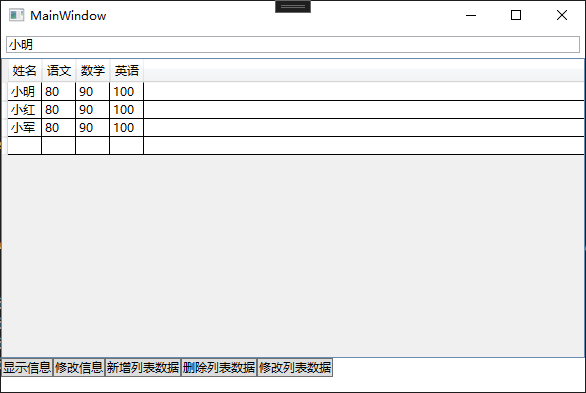1
2
3
4
5
6
7
8
9
10
11
12
13
14
15
16
17
18
19
20
21
22
23
24
25
26
27
28
29
30
31
32
33
34
35
36
37
38
39
40
41
42
43
44
45
46
47
48
49
50
51
52
53
54
55
56
57
58
59
60
61
62
63
64
65
66
67
68
69
70
71
72
73
74
75
76
77
78
79
80
81
82
83
84
85
86
87
88
89
90
91
92
93
94
95
96
97
98
99
100
101
102
103
104
105
106
107
108
109
110
111
112
113
114
115
116
117
118
119
120
121
122
123
124
125
126
127
128
129
130
131
132
133
134
135
136
137
138
139
140
141
142
143
144
145
146
147
148
149
150
151
152
153
154
155
156
157
158
159
160
161
162
163
164
165
166
167
168
169
170
171
172
173
174
175
176
177
178
179
180
181
182
183
184
185
186
| using System;
using System.Collections.Generic;
using System.Collections.ObjectModel;
using System.ComponentModel;
using System.ComponentModel.DataAnnotations;
using System.Linq;
using System.Windows;
using System.Windows.Input;
namespace MVVMTest {
public class Student : INotifyPropertyChanged {
private string name;
public string Name {
get => name;
set {
if (value != name) {
name = value;
PropertyChanged?.Invoke(this, new PropertyChangedEventArgs(nameof(Name)));
}
}
}
private int grade1;
public int Grade1 {
get => grade1;
set {
if (value != grade1) {
grade1 = value;
PropertyChanged?.Invoke(this, new PropertyChangedEventArgs(nameof(Grade1)));
}
}
}
private int grade2;
public int Grade2 {
get => grade2;
set {
if (value != grade2) {
grade2 = value;
PropertyChanged?.Invoke(this, new PropertyChangedEventArgs(nameof(Grade2)));
}
}
}
private int grade3;
public int Grade3 {
get => grade3;
set {
if (value != grade3) {
grade3 = value;
PropertyChanged?.Invoke(this, new PropertyChangedEventArgs(nameof(Grade3)));
}
}
}
public event PropertyChangedEventHandler PropertyChanged;
}
public class ViewModel : INotifyPropertyChanged, IDataErrorInfo {
public ViewModel() {
Students.Add(new Student { Name = "小明", Grade1 = 80, Grade2 = 90, Grade3 = 100 });
Students.Add(new Student { Name = "小红", Grade1 = 80, Grade2 = 90, Grade3 = 100 });
Students.Add(new Student { Name = "小军", Grade1 = 80, Grade2 = 90, Grade3 = 100 });
}
public event PropertyChangedEventHandler PropertyChanged;
private string name = "小明";
[MaxLength(10, ErrorMessage = "名字长度不能超过10")]
public string Name {
get => name;
set {
if (name != value) {
name = value;
PropertyChanged?.Invoke(this, new PropertyChangedEventArgs(nameof(Name)));
}
}
}
private ObservableCollection<Student> students = new ObservableCollection<Student>();
public ObservableCollection<Student> Students {
get => students;
set {
if (value != students) {
students = value;
PropertyChanged?.Invoke(this, new PropertyChangedEventArgs(nameof(Students)));
}
}
}
#region 命令定义
private RelayCommand _showMessageCommand;
public RelayCommand ShowMessageCommand => _showMessageCommand ?? (_showMessageCommand = new RelayCommand(ShowMessage));
private RelayCommand _modifyMessageCommand;
public RelayCommand ModifyMessageCommand => _modifyMessageCommand ?? (_modifyMessageCommand = new RelayCommand(ModifyMessage));
private RelayCommand _addStudentCommand;
public RelayCommand AddStudentCommand => _addStudentCommand ?? (_addStudentCommand = new RelayCommand(AddStudent));
private RelayCommand _deleteStudentCommand;
public RelayCommand DeleteStudentCommand => _deleteStudentCommand ?? (_deleteStudentCommand = new RelayCommand(DeleteStudent));
private RelayCommand _modifyStudentCommand;
public RelayCommand ModifyStudentCommand => _modifyStudentCommand ?? (_modifyStudentCommand = new RelayCommand(ModifyStudent));
private RelayCommand _windowLoadedCommand;
public RelayCommand WindowLoadedCommand => _windowLoadedCommand ?? (_windowLoadedCommand = new RelayCommand(WindowLoaded));
#endregion
#region 数据校验
public string Error => throw new NotImplementedException();
public string this[string columnName] {
get {
var validationResults = new List<ValidationResult>();
if (Validator.TryValidateProperty(
GetType().GetProperty(columnName).GetValue(this),
new ValidationContext(this) { MemberName = columnName },
validationResults))
return null;
return validationResults.First().ErrorMessage;
}
}
#endregion
#region 业务逻辑
public void ShowMessage(object parameter) {
MessageBox.Show(Name);
}
public void ModifyMessage(object parameter) {
Name = "xiaoming";
}
public void AddStudent(object parameter) {
Students.Add(new Student() { Name = "Tom", Grade1 = 60, Grade2 = 60, Grade3 = 60 });
}
public void DeleteStudent(object parameter) {
if (Students.Any()) {
Students.RemoveAt(0);
}
}
public void ModifyStudent(object parameter) {
if (Students.Any()) {
Students[0].Grade1 = 100;
}
}
public void WindowLoaded(object parameter) {
MessageBox.Show("Window Loaded!");
}
#endregion
}
public class RelayCommand : ICommand {
private Action<object> execute;
private Func<object, bool> canExecute;
public RelayCommand(Action<object> execute, Func<object, bool> canExecute = null) {
this.execute = execute;
this.canExecute = canExecute;
}
public event EventHandler CanExecuteChanged;
public bool CanExecute(object parameter) {
if (canExecute != null)
return canExecute(parameter);
return true;
}
public void Execute(object parameter) {
execute?.Invoke(parameter);
}
public void RaiseCanExecuteChange() {
CanExecuteChanged?.Invoke(this, EventArgs.Empty);
}
}
}
|
